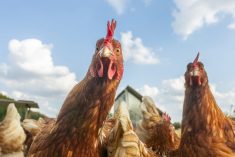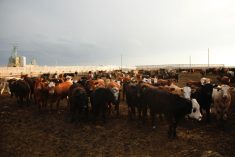(Resource News International) — Forage crop including pasture land, hay and silage crops across Western Canada vary in condition from province to province. But there’s one thing on which experts agree: the region’s forage crops need continued sunny, warm, dry weather to keep feed prices low for Canada’s livestock sector.
“If we get some good weather I think (conditions) will improve where producers can get out onto some of their tame hay fields,” said Pam Iwanchysko, forage and production specialist with Manitoba Agriculture, Food and Rural Initiatives at Dauphin.
Read Also

Trump tariff on Brazilian goods could jack up U.S. burger price
U.S. President Donald Trump’s plan for a 50 per cent tariff on goods from Brazil will likely raise prices for the beef that is used in American hamburgers, traders and analysts said on Thursday, as food manufacturers increasingly rely on imports during a time of declining domestic production.
Officials with the Saskatchewan ministry of agriculture and Alberta Agriculture and Rural Development agreed: favourable weather conditions are needed for pasture growth and for haying to get underway.
However, if weather conditions don’t improve forage producers still have some options, according to Andre Bonneau, forage management specialist with the Saskatchewan Ministry of Agriculture in Moose Jaw.
It’s possible, he said, for producers to take hay off a field that has excess moisture and wrap it instead of baling or hay preservatives can be added, which allows farmers to put away hay wetter than normal while still keeping the quality. There is also the option of silage, but the producer has to have the proper setup and storage facilities for the process.
“I think as time goes on over the next few weeks, and if the weather doesn’t straighten out, producers (in Saskatchewan) will be exercising those options,” said Bonneau.
Some haying has begun in Manitoba, Iwanchysko said, but producers are hesitant as they don’t want to get machinery bogged in their fields. Some alfalfa crops in the province have also been affected by flooding.
“The alfalfa (in Manitoba) is actually drowning out because alfalfa does not like to have wet feet for long periods of time,” said Iwanchysko.
Also, she said, the waterlogged fields have been restricting cattle to higher ground in pastureland, which could affect their weight gains.
Higher yields
Although excess moisture has cost some hay and pasture acres due to flooding, Bonneau said, the potential for higher yields this crop year could make up for the lost acres.
“Yield-wise, I would say pretty close to double the forage yield from traditional years,” Bonneau said of fields in Saskatchewan.
“There are some very beautiful forage crops if they haven’t been flooded out,” he said.
Grant Lastiwka, a grazing, forage, and beef specialist with Alberta Agriculture and Rural Development at Olds, agreed. In Alberta, he said, lost hay acres will be made up for in the yields of pasture for cattle producers.
“My presumption right now is that a lot of the shortfall to in hay yields are going to made up in terms of great yields of pasture for those producers in the beef industry,” he said.
There are also hopes cattle producers in Alberta can compensate for the loss of their hay yields with better pastureland, he said.
“We’ve got some good moisture in some areas where we’re hoping these people are going to offset their lack of hay yield maybe with greater pasture production so they might not need as much hay.”
Feed prices
Forage production in the West has the potential to play a major role in the price of cattle feed needed in the fall.
If cattle can’t feed well on pasture land they’ll need additional fattening, but if there’s a lack of hay or an abundance of poor-quality hay, producers could see higher feed prices for another consecutive year.
“In areas where the yields are doubled and the livestock numbers are high, prices will go down as long as (the crop) comes off dry and clean,” Bonneau said. “If (the crop) comes off black, or in poor shape, good hay may go up in price.”
Iwanchysko agrees: “We need a couple of good weeks of good haying weather to get some good quality feed up for the animals.”
However, Lastiwka is confident prices will go down because the cattle market will not be able to afford a consecutive year of higher feed costs.
“The beef industry won’t be able to pay… I don’t foresee them having the cash flow to do it this year.”


















